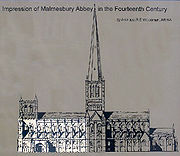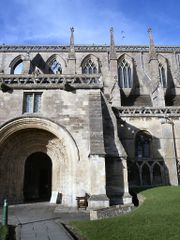
Malmesbury Abbey
Encyclopedia

Malmesbury
Malmesbury is a market town and civil parish located in the southern Cotswolds in the county of Wiltshire, England. Historically Malmesbury was a centre for learning and home to Malmesbury Abbey...
in Wiltshire
Wiltshire
Wiltshire is a ceremonial county in South West England. It is landlocked and borders the counties of Dorset, Somerset, Hampshire, Gloucestershire, Oxfordshire and Berkshire. It contains the unitary authority of Swindon and covers...
, England, was founded as a Benedictine
Benedictine
Benedictine refers to the spirituality and consecrated life in accordance with the Rule of St Benedict, written by Benedict of Nursia in the sixth century for the cenobitic communities he founded in central Italy. The most notable of these is Monte Cassino, the first monastery founded by Benedict...
monastery
Monastery
Monastery denotes the building, or complex of buildings, that houses a room reserved for prayer as well as the domestic quarters and workplace of monastics, whether monks or nuns, and whether living in community or alone .Monasteries may vary greatly in size – a small dwelling accommodating only...
around 676 by the scholar-poet Aldhelm, a nephew of King Ine of Wessex
Ine of Wessex
Ine was King of Wessex from 688 to 726. He was unable to retain the territorial gains of his predecessor, Cædwalla, who had brought much of southern England under his control and expanded West Saxon territory substantially...
. In 941 AD, King Athelstan
Athelstan of England
Athelstan , called the Glorious, was the King of England from 924 or 925 to 939. He was the son of King Edward the Elder, grandson of Alfred the Great and nephew of Æthelflæd of Mercia...
was buried in the Abbey. By the 11th century it contained the second largest library in Europe and was considered one of the leading European seats of learning. It was one of the few English houses with a continual history from the 7th century through to the Dissolution of the Monasteries
Dissolution of the Monasteries
The Dissolution of the Monasteries, sometimes referred to as the Suppression of the Monasteries, was the set of administrative and legal processes between 1536 and 1541 by which Henry VIII disbanded monasteries, priories, convents and friaries in England, Wales and Ireland; appropriated their...
. It is dedicated to Saint Peter
Saint Peter
Saint Peter or Simon Peter was an early Christian leader, who is featured prominently in the New Testament Gospels and the Acts of the Apostles. The son of John or of Jonah and from the village of Bethsaida in the province of Galilee, his brother Andrew was also an apostle...
and Saint Paul
Paul of Tarsus
Paul the Apostle , also known as Saul of Tarsus, is described in the Christian New Testament as one of the most influential early Christian missionaries, with the writings ascribed to him by the church forming a considerable portion of the New Testament...
. The 12th-century historian William of Malmesbury
William of Malmesbury
William of Malmesbury was the foremost English historian of the 12th century. C. Warren Hollister so ranks him among the most talented generation of writers of history since Bede, "a gifted historical scholar and an omnivorous reader, impressively well versed in the literature of classical,...
was of the community.
The Abbey was substantially completed by 1180. The 431 feet (131 m) tall spire
Spire
A spire is a tapering conical or pyramidal structure on the top of a building, particularly a church tower. Etymologically, the word is derived from the Old English word spir, meaning a sprout, shoot, or stalk of grass....
, and the tower it was built upon, collapsed in a storm around 1500 destroying much of the church, including two thirds of the nave
Nave
In Romanesque and Gothic Christian abbey, cathedral basilica and church architecture, the nave is the central approach to the high altar, the main body of the church. "Nave" was probably suggested by the keel shape of its vaulting...
and the transept
Transept
For the periodical go to The Transept.A transept is a transverse section, of any building, which lies across the main body of the building. In Christian churches, a transept is an area set crosswise to the nave in a cruciform building in Romanesque and Gothic Christian church architecture...
. The west tower fell around 1550, demolishing the three westernmost bays of the nave. As a result of these two collapses, less than half of the original building stands today.

Dissolution of the Monasteries
The Dissolution of the Monasteries, sometimes referred to as the Suppression of the Monasteries, was the set of administrative and legal processes between 1536 and 1541 by which Henry VIII disbanded monasteries, priories, convents and friaries in England, Wales and Ireland; appropriated their...
in 1539 by Henry VIII
Henry VIII of England
Henry VIII was King of England from 21 April 1509 until his death. He was Lord, and later King, of Ireland, as well as continuing the nominal claim by the English monarchs to the Kingdom of France...
and was sold, with all its lands, to William Stumpe, a rich merchant. He returned the abbey church to the town for continuing use as a parish church, and filled the abbey buildings with twenty looms for his cloth-weaving enterprise. Today Malmesbury Abbey is in full use as the parish church
Parish church
A parish church , in Christianity, is the church which acts as the religious centre of a parish, the basic administrative unit of episcopal churches....
of Malmesbury, in the Diocese of Bristol
Diocese of Bristol
The Diocese of Bristol is a Church of England diocese in the Province of Canterbury, England. It is based in the city of Bristol and covers South Gloucestershire and parts of north Wiltshire to Swindon...
. The remains still contain a fine parvise
Parvise
Parvise or parvis may refer to:#A room over the porch of a church — quite often found in Norman churches in England. In some churches these rooms were used for school rooms and in Castle Ashby was the home of a woman - who saved the manor house from burning when she saw the fire taking hold from...
which holds some examples of books from the Abbey library. The Anglo-Saxon charters
Anglo-Saxon Charters
Anglo-Saxon charters are documents from the early medieval period in Britain which typically make a grant of land or record a privilege. The earliest surviving charters were drawn up in the 670s; the oldest surviving charters granted land to the Church, but from the eighth century surviving...
of Malmesbury, though extended by forgeries and improvements executed in the abbey's scriptorium
Scriptorium
Scriptorium, literally "a place for writing", is commonly used to refer to a room in medieval European monasteries devoted to the copying of manuscripts by monastic scribes...
, provide source material today for the history of Wessex
Wessex
The Kingdom of Wessex or Kingdom of the West Saxons was an Anglo-Saxon kingdom of the West Saxons, in South West England, from the 6th century, until the emergence of a united English state in the 10th century, under the Wessex dynasty. It was to be an earldom after Canute the Great's conquest...
and the West Saxon church from the seventh century.
During the English Civil War
English Civil War
The English Civil War was a series of armed conflicts and political machinations between Parliamentarians and Royalists...
, Malmesbury is said to have changed hands as many as seven times, and the abbey was fiercely fought over. Hundreds of pock-marks left by bullets and shot can still be seen on the south, west and east sides of Malmesbury Abbey walls. The Abbey was the site of an early attempt at human flight when, in 1010, the monk Eilmer of Malmesbury
Eilmer of Malmesbury
Eilmer of Malmesbury was an 11th-century English Benedictine monk best known for his early attempt at a gliding flight using wings.- Life :...
flew a primitive hang glider from a tower. Eilmer flew over 200 yards (200 m) before landing, breaking both legs. He later remarked that the only reason he did not fly further was the lack of a tail on his glider.
Today much of the Abbey survives. The existing third of the nave has been restored as an active place of worship
Place of worship
A place of worship or house of worship is an establishment or her location where a group of people comes to perform acts of religious study, honor, or devotion. The form and function of religious architecture has evolved over thousands of years for both changing beliefs and architectural style...
and there are plans to build a visitor centre
Visitor center
A visitor center or centre , visitor information center, tourist information center, is a physical location that provides tourist information to the visitors who tour the place or area locally...
on the site. No charge is made for visitors to view the interior of the abbey. Supposedly the first person to be killed by a tiger in England, Hannah Twynnoy
Hannah Twynnoy
Hannah Twynnoy is reputedly the first person on record to have been killed by a tiger in Britain.Hannah Twynnoy was an early 18th-century barmaid working in a pub in the centre of the English market town of Malmesbury in Wiltshire....
, is buried in the churchyard. She was an early 18th century barmaid working in a local public house
Public house
A public house, informally known as a pub, is a drinking establishment fundamental to the culture of Britain, Ireland, Australia and New Zealand. There are approximately 53,500 public houses in the United Kingdom. This number has been declining every year, so that nearly half of the smaller...
, killed on October 23, 1703.
Images
 |
 |
 |
 |
External links
- Official website
- Malmesbury Abbey at Window on Wiltshire's Heritage.
- Image directory of Malmesbury Abbey at ArtServe.
- Malmesbury Abbey at The Normans: A European People.

